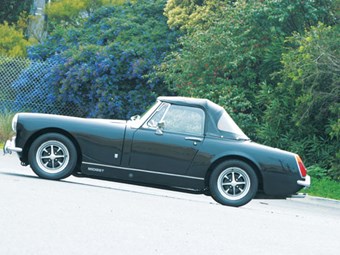MG Midget (1961-79): Buyers Guide
MG Midget (1961-79). Don't hand over the cash until you've read this

|
|
Buyers Guide: MG Midget
|
MG Midget (1961-1979)
WHAT IS IT?
Designing one car and selling it in several different guises was a British Motor Company forte. BMC's Sprite was badged from inception as an Austin-Healey but second-generation Sprites shared all but grille and badges with an MG that revived the pre-WWII 'Midget' designation.
Until 1967, Australians only got the Sprite, but once BMC's association with the Healey family was terminated, Midget and MG badging replaced the Sprite name. Aussie Midgets used BMC's willing twin-carb 48kW 1275cc engine and had a top speed around 150km/h. A revamp during 1970 brought new colours, a black plastic grille, and improved interior. Local assembly ended in 1972.
In late-1974, the long-serving A-series engine was replaced by a 1.5-litre unit shared with the Triumph Spitfire. Revised bumper mounts and huge bumpers added 75kg and it also lost 7kW to emission controls. Sales continued until 1979, with almost 225,000 built in total.
HOW'S IT DRIVE?
With the top stowed, access to the cramped cockpit is relatively easy. Inside, the big wheel is close and rearward seat adjustment limited. Driving in the wet is sketchy, with restricted rear vision when the top is in place, and pathetic demisting.
The engine pulls to 6000rpm and it does 0-96km/h in 13.2sec. The unassisted brakes easily stop the 730kg Midget.
The four-speed transmission fitted to 1.3-litre cars lacks first-gear synchro but the engine will pull from very low speeds in second. Once the gearbox oil warms, shifts should be crisp and crunch-free. Reverse can be hard to engage when cold and even selecting first can be difficult.
Handling is safe with mild understeer dominant and gentle lift-off oversteer. The cart-sprung rear-end doesn't like rougher roads but the structure is tough. Fittings are adequate with a speedo, tacho, temperature and fuel gauges - a basic heater/demister was a local requirement.
CHECKLIST
Rust attacks superficially and structurally so new paint may be concealing 'quickie' repairs. Wheelarches, lower rear guards, battery shelf, inner sills, spring attachment points, cabin floors and firewall are common rot locations. Check for cracking around windscreen attachment points, drooping doors and loose bumpers.
Oil leaks are common and a constant haze means an engine overhaul is due. Overheating needs checking, but don't rely on the gauge. Check the dipstick for oil contamination. Synchro on second is frequently worn and crunches on downshifts are common. Crunching in higher gears signals more serious problems. Suspension is tough and simple and old-style lever-action shocks can be recoed or replaced with new items - converting suspension for telescopic shocks is advised.
Rear wheel cylinders leak and affect braking but repairs are simple and inexpensive. Worn splines inside the hubs of knock-on wheels manifest in clunking when accelerating or under brakes.
The electrics are Lucas, so make sure the lights, horn, wipers, heater and gauges all operate. Indicator stalks are fragile. Seat adjusters can be jammed and ensure seatbelts aren't frayed or sun damaged. The top should operate smoothly.
SPECIFICATIONS
MG Midget (1961-1979)
BODY: 2-door roadster
ENGINE: 948cc, 1275cc or 1493cc 4cyl, OHV, 8v, dual carburettors
GEARBOX: 4-speed manual
SUSPENSION: Independent, upper & lower wishbones, coils, lever-action shocks, anti-roll bar (f); semi-elliptic springs, lever-action shocks
PRICE: $3500-13,000
Unique Cars magazine Value Guides
Sell your car for free right here
Get your monthly fix of news, reviews and stories on the greatest cars and minds in the automotive world.
Subscribe

.jpg)











